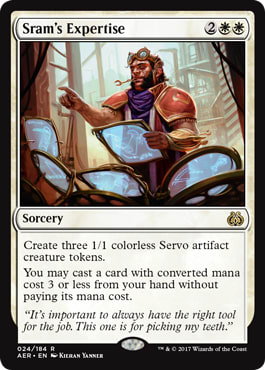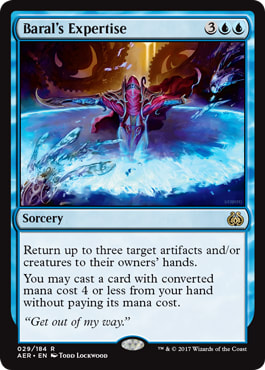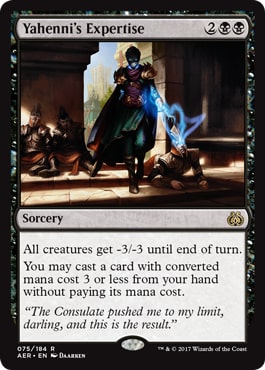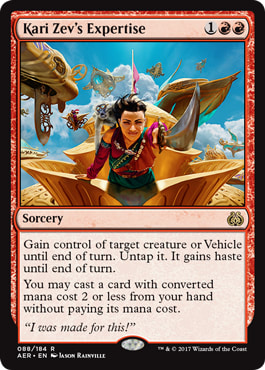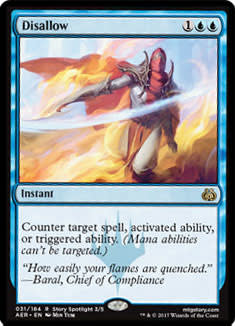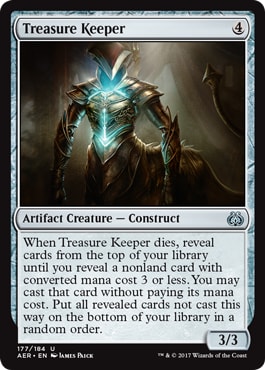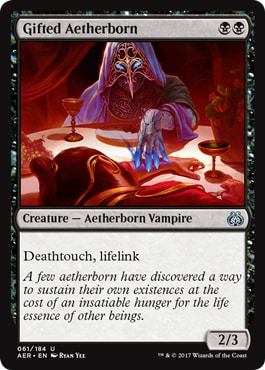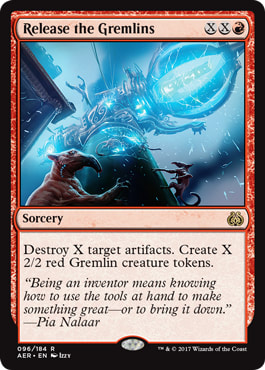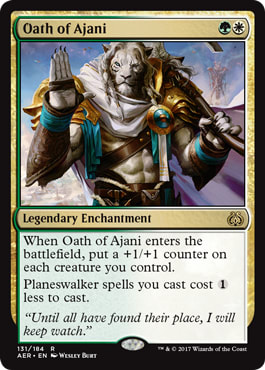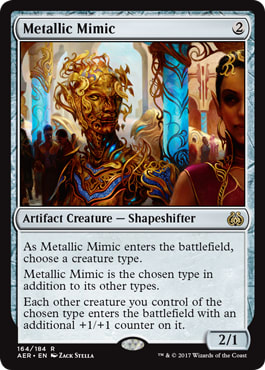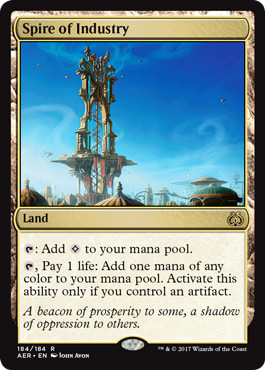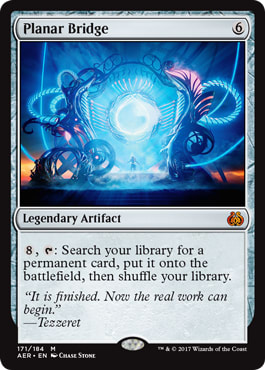Welcome back to part 2 of my review of Aether Revolt for Cube! We'll be discussing the rest of the cards for Cube, starting with the expertise cycle.
The expertise cycle mostly mimics other cards while tacking on the ability to cast a spell for free. The price for that is either a more awkward cost (Kari Zev's Expertise compared to Threaten), or a higher cost than what it'd normally cost (the rest of them, as Sram's Expertise's closest analog is Hordeling Outburst, which costs ![]()
![]()
![]() compared to
compared to ![]()
![]()
![]() .) Some don't have direct analogues but we can figure out about how much mana those would cost.
.) Some don't have direct analogues but we can figure out about how much mana those would cost.
It's easy to compare the expertise cycle to cascade cards: since they allow you to cast something cheaper in addition to them for free. However, cascade put constraints on what you could put in your deck; decks like Living End famously show this by building around it so that the only cascade targets are its namesake — Living End.
That said, a lot of the time, in Cube, cascade cards generally played more as value cards that don't require too much build-around as a deck that plays Bloodbraid Elf generally aren't going to find many “misses” aside from X-spells like Bonfire of the Damned, or an awkwardly timed Rancor, but it wouldn't be splashed in an Izzet counterspell-heavy deck due to the number of misses that it may get.
It wasn't until Pat Chapin and Mike Flores' Top Level Podcast episode talked about the Urza's Saga “free cards” at 31:53 (Treachery, Time Spiral, Peregrine Drake) that it made the power of the free spell offered a bit more clear. There are some things that the expertise cycle can't do:
- As these aren't creatures, they can't be blinked for extra use.
- By requiring you to cast the spell on your main phase as part of casting the Expertise, you can't hold up mana for instants, instant-speed mana usage nor cards with flash.
- Nor can you cast things like X spells with it, like Hangarback Walker or Bonfire of the Damned, but this is a relatively minor drawback.
Therefore, it's not exactly the same, but the analog isn't that far off. Like with the Urza's Saga cards, not all of them are strong enough to make waves in all Cubes — cards like Great Whale don't really do enough for their cost to be worth it for a Cube environment, but a few all-stars like Treachery certainly do.
It's important to realize that you won't always be casting Liliana of the Veil/Liliana, the Last Hope/Ancestral Vision off of Yahenni's Expertise, but much like how Primeval Titan can't always get Kessig Wolf Run and Library of Alexandria, what they end up realistically doing in Cube makes them good.
What the expertise cards all have in common are that they allow the caster to push momentum forward while performing a big effect, allowing for tempo-positive plays. I found the sum of the parts (the spell + the free spell) more than makes up for the slightly higher cost that is paid up front. It's true that a counterspell can gum up the works, but that isn't enough to pull value from these cards.
Sram's Expertise has the most obvious analog by being Hordeling Outburst for 1 mana for the “expertise tax.” Although it, in theory, can generate a ton of chump blockers and drop a Planeswalker for control decks, those decks are typically more in the market for something like a Wrath or a
Planeswalker. However, I've found that proactive White decks that seek to use the free spell to further develop their board state, either with a way to boost those creatures or another permanent, have used Sram's Expertise incredibly well. Like with Rishkar, Peema Renegade, Sram's Expertise can make a strong board state appear out of nowhere and living the dream of putting a 3-mana Planeswalker into play with Sram's Expertise means that the opponent has to deal with a multi-pronged attack.
It's a cliché that White 4-drops are very competitive in Cube and as such, the ones to consider really need to have enough raw power to compete with existing options. Thankfully, Sram's Expertise does.
Baral's Expertise looks like it may not have enough impact in Cube as a clunky multi-bounce spell that hits artifacts as well, but this ability gives it game in matches where the opponent may only have a creature or two to bounce. As can be expected, Baral's Expertise is a powerful tempo card, but it isn't just one for tempo decks as it's great in Blue control as a tap-out card, since it allows you to deal with the opponent's board state while presenting a threat of your own.
Being able to bounce multiple things lets you do things like bounce your own value creatures, which is something that doesn't usually doesn't happen with single-target bounce cards like Into the Roil.
Cryptic Command used to be called the “Blue Wrath of God” and while Baral's Expertise isn't Cryptic Command, nor is it Mystic Confluence (because both of those cards are incredibly powerful,) it's good to think of it as a kind of a Wrath of God — sometimes it only stops one threatening creature and it's fine; it feels bad using a card that feels like it should deal with more creatures but it's still a fine use for it. As you can imagine, bouncing several creatures and following up with a Planeswalker that doesn't have to deal with an opposing board state is an amazing feeling and is one that I've found to be a great addition to Blue decks.
Yahenni's Expertise is yet another Damnation lite for Cube. Since Languish brought on the death knell of unconditional 4-mana wraths in Standard, this is the new face of Wrath effects and I've found that Yahenni's Expertise is the best non-Damnation, non-Toxic Deluge Black wrath for Cube.
If I had my druthers, I'd rather have Yahenni's Expertise give -4/-4 rather than -3/-3 as it does reduce the number of things that die to the wrath, but it not killing X/4s does provide some opportunities for use. Much like other symmetrical cards like Wildfire, since on-color cards like Kalitas, Traitor of Ghet, Batterskull and Thought-Knot Seer without needing to reach out into other colors for options like Spellskite, Restoration Angel and Goblin Dark-Dwellers.
I've found that Yahenni's Expertise does give some real payoff for building around it, like Wildfire, since the potential payoff for having a threat that survives Yahenni's Expertise and being able to play something that either can survive it or develop your board state is quite high, whereas something like Languish, as good as it is, just wipes the board. I've seen some Black decks utilize it well by drafting several X/4s like Kalitas, Restoration Angel and Planeswalkers. Later in the article, I'll discuss a 3-0 Rakdos deck that used it as a general value wrath that had some things that lived through it, some things that died, and generally just liked having the ability to get an absurd amount of value by casting something for free. One other nice thing I found for it was that it did have some nice in-color synergies, like being able to cast an Edict effect to kill whatever lived through the Expertise, or even something as innocuous as a mana rock to accelerate.
Yahenni's Expertise's inability to kill X/4s and larger does mean that drafters will need to be aware of this in the draft process, but I've found this isn't a very hard feat to accomplish and despite feelbads with sometimes making it so that your wrath can't deal with an opposing threat, it's an outstanding Black card for Cube.
Kari Zev's Expertise is a top-tier Red aggressive card, easily the best Threaten effect we've had, even better than the stellar Frenzied Fugue that we got just last year. While it isn't stapled onto a creature like Zealous Conscripts, this just means that it fills a different role in the deck — not as a top-of-the-mana-curve finisher, but a very solid rate of return for points of damage that typically ends games quickly.
Historically, Threaten-style cards like Mark of Mutiny, Act of Aggression and Hijack have been underrepresented in Cube due to their timing windows when they can be played, whereas standard removal like Go for the Throat and the various Lightning Bolts can be played whenever to get rid of an opponent's creatures.
So why so many words on Kari Zev's Expertise, yet another Threaten variation? In order to fully understand the power of Kari Zev's Expertise, let's look at the primary modes when play Threaten-style effects are played:
- Mode A: stealing an opponent's blocker and attack with it to deal enough damage to kill the opponent, who likely just cast a large creature to help them stabilize and turn the corner.
- Mode B: steal a blocker and alpha strike to deal enough damage so that the opponent is nearly dead, to be finished off shortly after from direct damage or an attack next turn.
- Creatures (11)
- 1 Goblin Guide
- 1 Hellrider
- 1 Jackal Pup
- 1 Keldon Marauders
- 1 Monastery Swiftspear
- 1 Murderous Redcap
- 1 Rakdos Cackler
- 1 Reality Smasher
- 1 Reckless Bushwhacker
- 1 Porcelain Legionnaire
- 1 Zurgo Bellstriker
- Planeswalkers (2)
- 1 Chandra, Pyromaster
- 1 Koth of the Hammer
- Instants (5)
- 1 Burst Lightning
- 1 Char
- 1 Fireblast
- 1 Incinerate
- 1 Lightning Strike
- Sorceries (2)
- 1 Kari Zev's Expertise
- 1 Wheel of Fortune
- Enchantments (1)
- 1 Sulfuric Vortex
- Artifacts (2)
- 1 Grafted Wargear
- 1 Shrine of Burning Rage
- Lands (17)
- 13 Mountain
- 1 Wastes
- 1 Mishra's Factory
- 1 Strip Mine
- 1 Wasteland
Kari Zev's Expertise doesn't get around it being unusable if the opponent has nothing to steal or if stealing a blocker isn't going to really do anything, like if the opponent is at 20 and cast a Titan as a Threaten isn't going to save you in those scenarios, but then again, not much else in the Red aggro toolkit would either.
Think of cards like Smash to Smithereens and Searing Blood and how they work so well for Red aggressive decks. Both of these cards represent performing an action that Red aggressive decks want to do while still pushing forth the primary game plan of dealing damage in the early stages of the game.
Consider if an opponent casts a Coalition Relic on turn three and you have a Jackal Pup and a Stormblood Berserker in play. Destroying the Coalition Relic may be in your best interest, but it's being counterproductive to your deck's goal — trying to apply as much damage as possible — and Disenchanting is essentially taking a turn off of that game plan. Smash to Smithereens and (Searing Blaze, if this was instead an Eldrazi Displacer) work well in that role by allowing you to push momentum forward while still applying disruption.
Kari Zev's Expertise works in that same fashion for both modes of Threaten by representing a strong rate of return for damage. Consider this Mono-Red deck that 3-0ed with it:
Mono-Red Sample Deck ? Cube | Usman Jamil
Not all of the 1-drops and 2-drops are perfect with Kari Zev's Expertise, but the drafter said that most of the time when it was cast, it was for a damage source either that turn, or shortly after.
An overlooked aspect of Kari Zev's Expertise with mode B is that it can help you cast a defender so that you don't die to the backswing. Sometimes, it's necessary to drop a warm body on defense so that you don't die to your opponent cracking back and Expertise enables you to maintain the offensive while not losing tempo due to mana constraints. That said, when I've seen it cast, most of the time, it's going right for the jugular, casting another spell with the full intention of it being something that is either damaging the creature now, or later. Presently, this card is underrated due to how Threaten effects are underrepresented in Cube and the weirdness in how the expertise cycle plays out, but this is a solid addition to Red aggro decks.
Rishkar's Expertise — A lot of these kinds of cards that rely on another creature for a huge benefit usually end up underperforming. Think of how hyped Momentous Fall was and how it ended up being poor because even though it promised a high rate of return for the cost of sacrificing a creature, it would be easy to break up. Cards nowadays in that vein like Garruk, Primal Hunter's ability trend toward not targeting, but can still be awkward if your big threat dies in response. These types of effects tend to get further hampered by mass removal, stranding a card that is contingent on other creature(s) to be played in hand.
I've found that the floor for use asks for having a 2/2 or higher in play, but the real sweet spot is a 3/3 or higher. Unlike the other expertises, there isn't a direct analog for this kind of card — especially in Green, but as Harmonize costs ![]()
![]()
![]() , let's say that this “costs”
, let's say that this “costs” ![]()
![]()
![]() (this method isn't perfect, but it's something,) making it have the highest expertise tax. Although the drafter who had it noted that casting when chaining a draw 3 from a 3-power creature into Thragtusk is absurd, the inherent reliability on other creatures and the overpriced nature of the spell itself makes it the worst expertise of the cycle and
(this method isn't perfect, but it's something,) making it have the highest expertise tax. Although the drafter who had it noted that casting when chaining a draw 3 from a 3-power creature into Thragtusk is absurd, the inherent reliability on other creatures and the overpriced nature of the spell itself makes it the worst expertise of the cycle and
I wouldn't fault anyone for not running in their Cube.
The rest of the cards
Disallow — 3-mana counterspells like Dissolve, Scatter to the Winds, and Void Shatter, which represent the new era of post-Mana Leak counterspells, never really got much traction in a Cube because, despite them representing a bonus over a 2-mana counterspell, holding up 3 mana's significantly harder, as well as significantly easier to tell as holding open counterspell mana. Voidslime was printed years ago, but as we know, multicolored slots are super tight, leading to cards like Putrid Leech, which would be likely a staple in ![]()
![]() or
or ![]()
![]() , but doesn't make a lot of Cubes nowadays because of competition in
, but doesn't make a lot of Cubes nowadays because of competition in ![]()
![]() .
.
But since it represented a unique suite of abilities with powerful potential, when Disallow was first shown, I aggressively asked for feedback as I started trying it out as soon as it was played, as Stifle doesn't get played in (most) Cubes but it represents one that is incredibly powerful when it works.
The answer that I always received was that always a Cancel. Typically the answer was something along the lines of “the option to Stifle was nice but it just never came up.” This likely is because most triggers that are beneficial tend to be tacked onto spells and, for the most part, countering the spell deals with the triggers (exceptions like Eldrazi aside) and for others, using ![]()
![]()
![]() to stop something like a Planeswalker ability generally isn't worth the mana and the cost, whereas using
to stop something like a Planeswalker ability generally isn't worth the mana and the cost, whereas using ![]() for Stifle is more acceptable. I gave it nearly 2 months of weekly Cube draft play and having its Stifle ability never come up, so it appears to be safe to say that in almost all instances, it's going to be Cancel in Cube.
for Stifle is more acceptable. I gave it nearly 2 months of weekly Cube draft play and having its Stifle ability never come up, so it appears to be safe to say that in almost all instances, it's going to be Cancel in Cube.
In previous articles, I talked about how cards that offer multiple options tend to need a good base mode to be good in Cube — as cards like Collective Defiance tend to be a bit too pricey on their base mode of ![]()
![]()
![]() to work well in Cube decks, whereas something like Burst Lightning has a much easier time. After trying it out for nearly 2 months of weekly Cube drafts and never delivering on Stifling anything, it didn't offer enough bonus for Cube.
to work well in Cube decks, whereas something like Burst Lightning has a much easier time. After trying it out for nearly 2 months of weekly Cube drafts and never delivering on Stifling anything, it didn't offer enough bonus for Cube.
Skyship Plunderer is yet another nice 2/1 for 2 in Blue the vein that we've been getting in the past few years, like Dimensional Infiltrator, offering a riff on proliferate. Matt Kranstuber's Blue-Based Tempo Cube article discussed how to push Blue-based attack decks in your Cube and Dimensional Infiltrator and Skyship Plunderer offer some more depth to that deck. Blue still hasn't gotten much at the 1-drop slot, but these cards give some additional tools for that as a support role. In Cubes that aren't going in that direction, Skyship Plunderer suffer from a bit of an identity crisis by being a solid card but in a color that doesn't really have a home for it, as control decks aren't really in the market for a 2/1 flier for 2 that boosts its Planeswalkers, as its cards generally are either card advantage, standalone threads or card neutralizers – Skyship Plunderer unfortunately not falling into either category, making it a rough include for many Cubes, but something to considering for the future or if you want to tailor your Blue section for that path.
Trophy Mage is analogous to Trinket Mage and Treasure Mage. Let's look at the raw number of targets, looking at the Cube Tutor 450-card average:
- Trinket: 10 – Chrome Mox, Everflowing Chalice, Mox Diamond, Bonesplitter, Mana Vault, Pithing Needle, Sensei's Divining Top, Skullclamp, Sol Ring, Hangarback Walker
- Trophy: 15 - Basalt Monolith, Chromatic Lantern, Coalition Relic, Crucible of Worlds, Grafted Wargear, Mimic Vat, Sword of Body and Mind, Sword of Feast and Famine, Sword of Fire and Ice, Sword of Light and Shadow, Sword of War and Peace, Vedalken Shackles, Worn Powerstone, Porcelain Legionnaire
- Treasure: 4 - Wurmcoil Engine, Myr Battlesphere, Sundering Titan, Inkwell Leviathan
The lack of targets for Treasure Mage illustrates why it doesn't tend to see much Cube play. Trinket Mage seems some Cube play and although the Cube Tutor 450-average doesn't have power, it does have de-facto “power” cards like Sol Ring and Mana Vault.
My experience with Trinket Mage was that it either needed a really good target (a piece of power, arguably a Sensei's Divining Top) or several other targets to make a good Trinket Mage package.
On the Life Begins at 20 video talking Trophy Mage, Mark talks about the non-overlap in targets, like how a deck that has Worn Powerstone wouldn't want a Grafted Wargear, whereas that doesn't tend to happen as often with Trinket Mage — these deck nonbos still can happen (Bonesplitter and Mana Vault.) Having multiple 3-mana artifacts can also clog your curve where that isn't as impactful for 0-1 mana artifacts.
Because of this, I've found that Trophy Mage generally needs at least one really good target to be worth it, like a Vedalken Shackles, a Sword, or (possibly) a Coalition Relic and because of that, the payoff was generally lacking.
Treasure Keeper features a riff on cascade that happens when the creature dies and unfortunately, that makes it hard to justify that for a 4-drop, when it needs to die to do anything worth talking about, making it a pass.
Gifted Aetherborn aka Vampire Nightwalk is another riff on Vampire Nighthawk, trading flying for 1 mana. This allows the creature to be more efficient as on its base rate, it's very efficient as a 3-toughness creature with deathtouch (with lifelink to boot,) letting it outmuscle 2/2s and trade up with creatures that it can't beat in a fair fight.
I talked about how Aerial Responder was in the Kaladesh review and how it was a hard sell in many cubes because we've gotten better 3s recently. Does Gifted Aetherborn suffer a similar fate?
It's true that it loses out on the potential that Vampire Nighthawk did that it did when playing Faeries in 2011 — acting as a lifegaining threat that is hard to block and can deal with just about anything in combat, flying or not. However, the increase in efficiency more than makes up for it, since it performs most of the same roles that it would have without flying. Gone are the days when Kamigawa dragons defined finishers as big fliers, as a lot of Cube finishers tend to be more low-to-the-ground types like Titans, a few exceptions aside like Griselbrand and both Emrakuls. ![]()
![]() can be somewhat awkward to hit but this isn't enough to render a defensive monster as this (one that can wear equipment incredibly well too) to be difficult to cast. Black 2-drops are still thin outside of a few and while this is no Dark Confidant, it's a solid one.
can be somewhat awkward to hit but this isn't enough to render a defensive monster as this (one that can wear equipment incredibly well too) to be difficult to cast. Black 2-drops are still thin outside of a few and while this is no Dark Confidant, it's a solid one.
Release the Gremlins is an upgraded Manic Vandal by being able to scale up when there's more artifacts in play, something unprecedented on a creature that kills mana rocks, at the cost of not being a creature and not be able to be cast without targets.
Generally I found that Manic Vandal and that family of creatures never were cast as just a Gray Ogre, in both Cubes with and without power. Being not a creature means that it loses out on some functionality (reanimation/blink.) It gains slightly less due to being a spell as cards that care about non-creature cards being cast, but that isn't enough to shift it to be in or out of a Cube, but may have in-game applications.
Release the Gremlins has worked well by having a rock-solid base mode in a card that's already being played in a lot of Cubes now, and I've found that isn't difficult to scale up (not just killing power cards), making it similar to a card like Mizzium Mortars and Burst Lightning — a card that performs a role that a deck wants at a decent base rate while providing a nice ability to scale up, which is useful if the opponent is either on artifact.dek or just happens to have several high-impact artifacts.
Another subtle use for it are that it can “multikick” to destroy your own useless mana rocks that aren't doing anything useful, or one that may be hurting you once their burst potential has been used up (Mana Crypt, Mana Vault.) These combined uses have made it a solid Red anti-artifact card thus far.
Felidar Guardian is making waves in Standard as part of a combo with Saheeli Rai but it suffers in Cube as a very mediocre 4-drop, a slot that's extremely competitive. Unlike cards like Deceiver Exarch and Pestermite which are fine as creatures to play as end-of-turn threats that can ambush blockers, Felidar Guardian is a bit underwhelming. It does allow for the permanent to return immediately, allowing for immediate use of beneficial triggers, rather than having to wait until end of turn for cards like Flickerwisp and Glimmerpoint Stag. Playing Felidar Guardian requires a critical mass of beneficial triggers or going deep on combo strategies to be worth playing in a deck, which may not be enough for a 4-drop in your Cube.
Ajani Unyielding — is a Planeswalker that does a lot. It's another Ob Nixilis Reignited style of Planeswalker, like Jace, Unraveler of Secrets, where its plus has some form of card advantage and its minus is some form of removal. His plus requires 20 targets to reliably hit 1.5 cards (and I found most good base Green decks generally had around that many, if only a few cards short), but since he typically lives to use the ability again and gains 2 loyalty while doing so, multiple iterations can make it so that it averages out to that amount, making him a great card advantage engine for those decks. Swords to Plowshares on a -2 is also great unconditional removal that still doesn't tend to happen that often on a White and/or Green planeswalker. Selesnya sections tend to have at least one big-mana effect to help the midrange decks and while this probably won't be kicking Mirari's Wake out of many Cubes, kicking something like a Dragonlord Dromoka may be a worthwhile endeavor for your Cube.
Oath of Ajani is a strong card that, like Renegade Rallier, suffers as Selesnya is very competitive. Since it only costs 2 mana, it seems like a card that should be cast on turn two, but much like Abbot of Keral Keep, it's one that can be played then, but one I found should be cost later in the game (although the Planeswalker cheapening text lets it act as a curve for getting out a turn three Gideon, Ally of Zendikar and then pumping creatures en masse) but as good as it is, good luck fitting it into your Cube.
Tezzeret the Schemer is another Dimir artifact-based Planeswalker that generates value and protects itself, but requires being played with a significant amount of artifacts to be playable in a Cube deck, but unfortunately doesn't really give the payoff that Tezzeret, Agent of Bolas does, as cliché as it sounds. Impressions that I got from drafters who played it in artifact-heavy decks was that it was generally solid and generated value, but that its minus sometimes just didn't quite protect itself well enough for the loyalty cost.
Dimir doesn't really have any busted Dimir cards, but it's in a space like Izzet was years ago, where it has a lot of solid cards like Ashiok, Nightmare Weaver, Baleful Strix, Far // Away, Dragonlord Silumgar, and Tezzeret, Agent of Bolas, but no clear tier-1 cards that need to be played head-and-shoulders above the rest. Unfortunately, the new Tezzeret falls in the lower echelons of this tier.
Lifecrafter's Bestiary operates somewhat like Thassa, God of the Sea as a scry engine with some upside to draw cards. It's easy to discount how impactful a 1-mana tax is to gain a benefit, especially when curving out and because of that, my general impression of the card was low and it ended up meeting these low expectations — it ended up just being too low-impact and too mana intensive. It sometimes helped to get use out of late-game mana dorks who weren't doing anything, but it wasn't really worth a slot in Green Cube decks.
Metallic Mimic — in the Conspiracy: Take the Crown review, I talked about how limiting these kinds of tribal cards are. It's nice that unlike Paliano Vanguard, you can at least choose what it does in the game itself and some types that generate multiple creatures, like Servo, Goblin, Soldier.
It's true that as it's a tribal card that becomes the target creature, it helps to push tribal strategies, but it really isn't enough to make a Cube designer suddenly want to push that strategy, nor enough payoff to make it perform significantly better in Cubes that do.
Scrap Trawler plays somewhat like Matter Reshaper, and suffers from what it does in that it's pretty mediocre since it doesn't do much if it (or other robots) doesn't die. You can set up some combo potential and use it as a poor man's Reveillark but still hard to really get and not really worth it for most Cubes.
Walking Ballista is a powerful artifact creature that offers lots of flexibility as an upgrade to Triskelion. My general impressions from several attempts of trying Triskelion in my and others' Cubes were that it was a bit too underwhelming for Cube outside of blink/reanimation shenanigans, which weren't really enough to pull me toward putting it in most decks. Walking Ballista has been significantly better as one that offers several base modes that work well in Cube, as it's not uncommon to see it cast for 2 or 4 mana. As referenced by those two articles, cards that have a “base mode” that deals with things effectively (a Doom Blade-esque threat removal at 2 mana, a Shock type of effect for ![]() ) tend to be the best flexible cards for Cube and Walking Ballista works in that manner.
) tend to be the best flexible cards for Cube and Walking Ballista works in that manner.
Decks that want to play Hangarback Walker generally want to play Walking Ballista as well, but they play somewhat differently.
Hangarback Walker tends to act as a defensive creature, since it can be cast for a good amount and requires minimal mana effort to boost and offers insurance in case it dies since it can swarm the board and create either an army that will close the game, or a bunch of chump blockers. However, it generally wasn't that good at turning the corner and Walking Ballista is exceptional at that role, since it can threaten to pump itself in combat and/or at end-of-turn while presenting an onboard clock, similar to how Seal of Fire does while it's in play.
Like Hangarback Walker, it's also nice as a mana sink, as artifact heavy decks can find themselves with the ability to make gobs of mana without a use for it, giving it uses for all of that mana while being cast and while in play.
Lastly, it also gives a bit of reach for direct damage for non-Red decks, which can make for awkward blocking situations, as an opponent can't just assume being at 1 life is fine if they're playing against a Simic deck. All in all, a Cube all-star.
Spire of Industry really helps decks that have a critical mass of artifacts (how many?) to fix their mana. It combines incredibly well with mana-fixing mana rocks, as I found that the combination of a Signet and Spire of Industry typically meant that the player had no problems casting anything thereafter, but the life loss was somewhat awkward when using it multiple times (although it was almost always a perfectly fine use of that resource.)
It can be used with artifacts like equipment, but I generally found that the mana rock decks like Wildfire decks were more in the market for it. As cliché as it may sound, if you're looking to bolster those decks, it may be worth looking into.
Lastly, I'll only briefly discuss these as I hadn't really thought of these cards until I talked to Cube savant Matt Kranstuber about how the set shaped out for Cube (our consensus was that it's absurd) and I'm not going to pretend that I came up with the idea to consider these cards, as the credit is all his and I'm sure he'll go into them in much more depth whenever he and Jack Grannan end up recording their Joy of Cubing Aether Revolt episode as I have no real-world experience with these:
Planar Bridge doesn't do anything when it comes into play and takes a few turns to go online, but if it can be used, it's a pretty absurd value engine as putting a high-impact permanent into play typically decides the game, and getting several activations almost assuredly does.
Dark Intimations has great potential as a value generator ala a mini-Cruel Ultimatum with some flavor text about Bolas planeswalkers.
Fourth Bridge Prowler a bit small, but does approach some unprecedented space as the world's smallest Flametongue Kavu without the damage drawback of Forge Devil that Matt expressed interest in and that Alex Ullman discussed for pauper constructed, but my general impressions are that it's too low-impact for Cube since it doesn't really kill enough, but when it works, the value generated is outstanding.
I hope you've enjoyed this journey through Aether Revolt and what it brings for Cube!
My blog, featuring my Pauper and powered Cube lists.
Cube podcast, The Third Power, that Anthony Avitollo and I host.
Find me on Twitter @UsmanTheRad
















